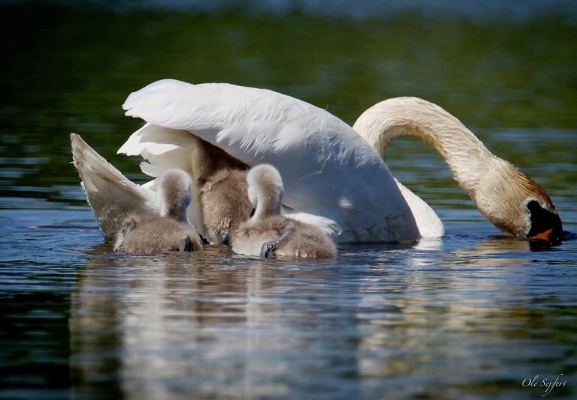Beyond Your Backyard🍃 How Animals Care for Their Young🦆🐥🐣
Swan with her Cygnets, starting to pile up for a ride. Photo by Ole Sejfert
Kimberly J. Epp.
Animals, especially mothers, are very protective over their young. In some cases, such as with Canada Geese, both parents care for their goslings. Both male and female chickadees care for their banditry. In fact, in nine out of ten songbirds, both parents help in the raising of the brood. The Ruby-Throated Hummingbird mothers, however, have to go it alone. Regardless of the presence of papa birds, mama birds still rule the nest!
Least Tern protecting her chick. Photo by Bobby Harrison
It's that time of the year when the babies are starting to come into full view. A family of five squirrels keep my cats entertained daily from their perch on my desk. Remember to enjoy these moments from a distance so as not to scare the mothers or their young. Remember that mammal mothers often leave their young as they go off and feed. So don't assume they are orphaned. Also, please always keep your cats inside.
Grebes, swans and loons provide protection to their young by even giving them rides on their backs. The young seek protection from the elements under their wings as well. Many of the waterfowl parents are aggressive, so never get too close to their babies. Some birds, such as the Killdeer, will pretend to have a broken wing and slowly lead the predators away from the nest or chicks. The male Rock Ptarmigan will attract attention towards himself, while detracting predators from the camouflaged female on her hidden nest on the tundra.
Possum mom's carry their young around on their backs until it becomes almost impossible to walk. The babies stay with their mom's until about 4 months of age. They are devoted mothers indeed. Harp seals, on the other hand only care for their young for the first 12 days. After that, they are on their own and are very vulnerable to predation. Only when they are 8 weeks old, and after having lost half of their body weight, can they go off and hunt on their own. So harp seals don't win the medal for motherly care!
Songbirds feed their chicks insects and worms as many as 4 to 12 times an hour. They regurgitate this food directly into the beaks of their young. Animals learn by copying their parents. Some animals have several broods a year, while some larger mammals care for their young for two years or more.
Canada Goose with tiny gosling under her wing. Mama plucked the down from her breast to line her nest and keep the goslings warm. Photo by Kimberly J. Epp.
Attentive Polar Bear mothers usually give birth to twin cubs that stay with her for two years as they learn the skills of survival in a cold climate that is gradually changing.
A young Porcupine, known as a Porcupette, is born with quills that harden soon after birth. After only eight weeks with it's mother, it is left to go off on its own. The largest land mammal on earth cannot go without mention, as the African Elephant has the longest land mammal gestation period - with a total of 22 months. These elephant calves nurse for their first 6 years. Even after they are weaned, the males may stay with their mothers until they are about 16 years of age. Females may stay in the herd for their entire lives.
Make sure and take some time to observe the interactions of animals and their young around you this Spring. Crescent Park, Wakamow, the former Wild Animal Park, Buffalo Pound Provincial Park and the Regina Bird Sanctuary are some areas I recommend visiting if you live in the Moose Jaw area - but there are so many wonderful parks within our province where you can go to observe wildlife.
White-Tailed Deer doe and fawn. Photo by Amy Pruett
For this coming Father's Day, I will write a special segment on how animal fathers care for their young. So please stay tuned! 🦁🐧
-----------------------------------------------------------------------
Epp is an Environmental Educator and writer and is also the President of the Moose Jaw Nature Society. She can be reached at kepp@shaw.ca.
Cover photo: Bison cow and her one - month old calf. Photo by Michael St. Laurent




